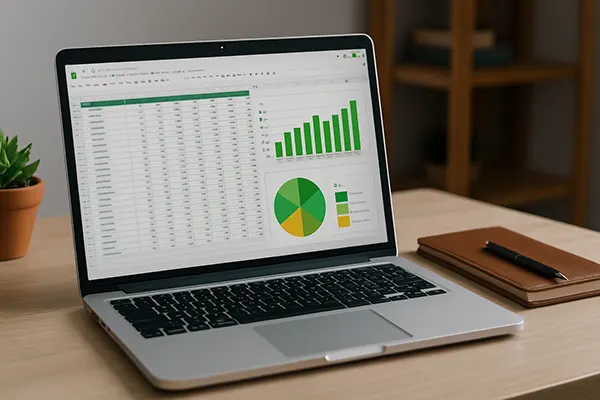
How to Earn Money by Selling Google Sheets Templates
Creating and selling Google Sheets templates has evolved into a practical and sustainable source of online income for creators, financial experts, and productivity enthusiasts. These templates, especially in the realm of finance and habit tracking, are in high demand due to their ease of use and time-saving potential. As of February 2025, the trend continues to grow, offering new opportunities for monetisation through marketplaces, personal websites, and niche communities.
Understanding the Demand for Google Sheets Templates
Google Sheets has become a preferred tool for millions thanks to its accessibility and flexibility. From budgeting and expense tracking to goal planning and investment analysis, users turn to pre-built templates to streamline repetitive tasks and improve accuracy. In 2025, this demand is especially high among freelancers, small businesses, and personal finance influencers who require efficient solutions without investing in custom software.
Templates that automate calculations, include built-in dashboards, and simplify complex data are particularly popular. For instance, budgeting templates that categorise expenses and display real-time analytics using pivot tables and conditional formatting are consistent bestsellers. Templates that offer both functionality and design — clean, intuitive layouts with custom branding options — stand out on marketplaces.
The growth of remote work and digital entrepreneurship has further fuelled the use of Google Sheets. Businesses and individuals alike seek affordable tools to manage finances, track performance, or schedule projects. This presents a unique opportunity for creators to meet this demand with ready-to-use, scalable solutions that can be easily adapted and reused.
Top-Selling Financial and Tracking Template Ideas
Among the bestsellers are personal budget trackers, debt repayment planners, freelance income reports, and subscription managers. These serve real-world needs and provide immediate value, which drives recurring sales. By including dynamic graphs and automated summaries, creators enhance usability and perceived value.
Health and habit trackers, such as workout logs and mental wellness journals, also perform well. These templates typically use dropdowns, checkboxes, and colour-coded progress bars to engage users visually and practically. Users appreciate templates that are not only useful but also motivate consistency in routines.
Inventory management sheets for Etsy shops or Amazon FBA sellers are another lucrative niche. Templates that help calculate cost per unit, profit margins, and restock schedules provide tangible business benefits. These are often bought by small business owners who may lack time or skills to build spreadsheets from scratch.
How to Design Google Sheets Templates that Sell
The success of a template heavily relies on its clarity, visual appeal, and ease of use. Before publishing a product, creators should thoroughly test it with real use cases and ensure that every formula is robust and error-free. Clean formatting, legible fonts, and logical flow contribute to a positive user experience.
Naming conventions for tabs and cells matter. Buyers expect intuitive navigation and immediate comprehension. Templates should include a README tab or quick guide with brief instructions for first-time users. This builds trust and reduces refund rates or customer support queries.
Design consistency is equally important. Use branded colour palettes or minimalist themes to make templates visually appealing. Tabs should be structured by function (e.g., input, output, charts) and protected to avoid accidental edits. Advanced users may also value templates with optional scripting or AppSheet integration for automation.
Tools and Resources for Template Creators
Several tools can elevate your template creation process. Add-ons like “Autocrat” or “Sheetgo” can automate tasks, while platforms like Canva help design visual elements such as covers or instructional diagrams. Using AI tools such as ChatGPT for copywriting instructional content is also increasingly common in 2025.
Figma and Loom can be used to create accompanying user manuals or walkthrough videos. A short demo increases perceived value and can significantly boost conversion rates on marketplaces like Etsy or Gumroad. Consider uploading demo videos to YouTube or embedding them in your listing pages.
Google Workspace Marketplace is another channel worth exploring, though it requires following stricter publication guidelines. Creators aiming to scale should invest time in learning script integration using Google Apps Script, which allows for dynamic custom functions and interactive tools.

Where and How to Sell Google Sheets Templates
Several platforms are well-suited for selling Google Sheets templates, including Etsy, Gumroad, Ko-fi, and personal websites powered by WordPress or Shopify. In 2025, Etsy continues to lead as a mainstream marketplace due to its traffic and low entry barrier. Listing optimisation with keywords and quality images is crucial for visibility.
Gumroad appeals to digital creators who want more control over pricing, bundling, and licensing. This platform allows for flexible pricing strategies such as “pay what you want,” discounts, or limited-time offers. It also integrates well with email marketing tools, which helps build repeat customers.
Launching a standalone website via Shopify or a custom WordPress theme offers branding opportunities and long-term scalability. With SEO-optimised blog content and lead magnets like free mini-templates, creators can attract and retain an audience while upselling premium products through email funnels.
Legal Considerations and Licensing
To protect your intellectual property, clearly define licensing terms. Most creators opt for personal-use licences, restricting resale or redistribution. It’s essential to include a terms-of-use page or PDF file with each download. For complex or high-value templates, consider registering your work with copyright offices in your country.
Ensure that your templates do not contain data scraping scripts or personal data, which may violate Google’s policies or regional privacy laws like GDPR. Templates should be built with ethical use in mind, especially if used in sensitive areas like finance or healthcare.
Offering customer support also builds trust and reduces legal risks. A basic FAQ or support email can go a long way in maintaining buyer satisfaction. In cases where templates include macros or custom scripts, providing clear disclosure helps avoid misunderstandings or returns.



